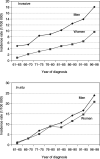Familial invasive and in situ squamous cell carcinoma of the skin
- PMID: 12778064
- PMCID: PMC2741043
- DOI: 10.1038/sj.bjc.6600909
Familial invasive and in situ squamous cell carcinoma of the skin
Abstract
We used the updated nation-wide Swedish Family-Cancer Database to examine familial risks in data from 1961 to 1998 on 1252 invasive and 2474 in situ squamous cell carcinoma (SCC) of the skin among offspring, and over 10 times more among parents. In 259 families a parent and an offspring had skin SCC. The familial standardised incidence ratios (SIRs) were 2.72 for invasive and 2.40 for in situ skin cancers in offspring. Multiple skin cancers in parents were associated with increased SIRs for invasive SCC in offspring, being 2.55 for one and up to 14.93 for two invasive and two in situ cancers in parents; the corresponding in situ SCC risks were 2.28 and 7.49. The population attributable fraction for any familial skin SCC, invasive or in situ, was 4.1%. Melanoma was the only discordant tumour that was associated with invasive and in situ skin SCC. These results provide evidence that there is an underlying hereditary susceptibility for at least a part of the familial clustering for skin SCC.
Figures
References
-
- Balajee A, Bohr V (2000) Genomic heterogeneity of nucleotide excision repair. Gene 250: 15–30 - PubMed
-
- Center for Epidemiology (2000) Cancer Incidence in Sweden 1998, pp 1–114, Stockholm
-
- de Boer J, Hoeijmakers JHJ(2000) Nucleotide excision repair and human syndromes. Carcinogenesis 21: 453–460 - PubMed
-
- Dong C, Hemminki K (2001a) Modification of cancer risks in offspring by sibling and parental cancers from 2112616 nuclear families. Int J Cancer 91: 144–150 - PubMed
-
- Dong C, Hemminki K (2001b) Second primary neoplasms in 633964 cancer patients in Sweden, 1958–1996. Int J Cancer 93: 155–161 - PubMed
MeSH terms
LinkOut - more resources
Full Text Sources
Medical
Research Materials


